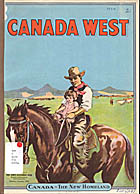 |


Library and Archives of Canada |


 |
 |


Library and Archives of Canada |


 |
 |


Library and Archives of Canada |
 |
|
A WORD FROM THE CURATOR
Sandra Morton Weizman
What this exhibition means to me
Acres of Dreams: Settling the Canadian Prairies is an exhibition
about the immigration and settlement of Western Canada. As a grandchild of
immigrants who came to the Prairies from Poland on one side, and the Ukraine
on the other, working on this exhibition has had great personal significance
for me. In the case of my own family, my paternal grandfather came to Edmonton
because he had an older brother there already. The brother came because he had
an uncle who came to Alberta as a homesteader at the turn of the last century.
So, going back three generations, my great-great-uncle probably responded to
some of the attractive posters and brochures distributed all over Eastern
Europe during Canadian Minister of the Interior Clifford Sifton's marketing
campaign. Or, perhaps he had heard stories or read letters from others from
his village who had gone before, just like so many who immigrated.
For me, personally, working on this exhibition provided the opportunity
to explore the background of why people came to Western Canada, their hopes,
their dreams, and the often harsh realities they faced upon arrival. We did
this through artifacts, photographs, letters, diaries and journals. The
exhibition is full of the voices of these immigrants telling their personal
stories — through audio, video, and quotes from their writings. While the
Canadian Government's marketing materials extolled the invigorating climate,
quotes from diaries and letters sent home spoke of having winter "13
months a year," and of the harshness of the climate. Some immigrants
wrote home to entice their friends and family to follow in their footsteps,
like the one who bragged of having "a home like a mansion, a large
cultivated field, and a wife who was dressed like a lady."
Why did we do this exhibition?
The Canadian Museum of Civilization wanted to create an exhibition to
commemorate the centennials of Alberta and Saskatchewan. What better way to
do so than to tell the story of how the West was promoted in the most
sophisticated marketing campaign that had ever been launched, offering 160
acres of free farming land. Their message was disseminated through posters,
brochures, motorized wagons, and agricultural fairs. For some immigrants,
the possibility of owning their own land was very enticing, particularly for
peasants in some parts of Eastern Europe, who would never have otherwise had
that opportunity. For other groups, a life free of religious persecution made
the offer so attractive. And, for still others, particularly for some British
and French settlers, it was the idea of building their nation and culture
as part of the westward expansion.
The Journey to a New Land
Part of the exhibition follows the journey people took to get to Western
Canada. From Europe, they came by ship, often in crowded and unsanitary
conditions in what was known as "steerage," landing in either
Halifax or Quebec City. Once on Canadian soil, they usually travelled for
days on trains, often in similar conditions. Or, they arrived in covered
wagons from the United States. One of my favourite artifacts in the exhibition
is a survey stake, with the lot number etched into it. Used to mark the land
claim of settlers so they would be able to find their new home, this stake is
a symbol of the barrenness that new settlers found upon arrival. After a
long and usually arduous journey, they arrived to a place where there was
no house, no community, swarms of mosquitoes, and often no neighbours nearby.
Putting Down Roots
For many immigrants, life continued to be a constant struggle once they
had settled. During the First World War, many, particularly of Ukrainian
origin, were interned in enemy alien camps under the War Measures Act.
Many experienced lives of discrimination and prejudice. They would break
their land, and yet the bountiful crops of wheat depicted on the marketing
posters were often eaten by grasshoppers, destroyed by frost, or shrivelled
by drought. Yet, despite all the adversity, many stayed, put down roots,
and succeeded in making a better life for themselves, their children, and
for their children's children.
|
 |